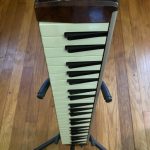Hammond-Suzuki 44 v2
- This topic has 19 replies, 6 voices, and was last updated 3 years, 3 months ago by
 André Sant’Anna.
André Sant’Anna.
-
AuthorPosts
-
December 22, 2020 at 5:16 am #12933
Antonio Freixas
ParticipantHi, eckso,
I have the 44Hv2 and the M37C. I do not find the 44H harder to play than the M37C; just the opposite.
It’s nice that you have three Hammonds to be able to experiment with. If indeed you put most of the 44H parts on the 44HP and obtained the tone of the 44H but the ease of the 44HP, then about the only place to left to look would be in the hidden chambers below the reeds and on to the exhaust ports. And the only way to check for differences there would be cut open the instruments! Ok, I suppose you could remove the reed plates and get a partial look.
You can hear me playing a 44Hv2 at https://youtu.be/jwUalR6XWjs. I’m not sure if that will give any insights.
Air distribution is a problem in most melodicas. It seems that the low notes are always stealing the air—the wider the spacing, the more the steal. Oscar has a way of balancing the notes on his custom designs. If you really want to hear balanced notes, though, get a Y-connector and hook up two separate melodicas. Play the low notes on one and the high notes on the other and you can hear truly balanced notes.
I have experience with only two models, though, so there may be commercial instruments that do as well as my gold standard (the two melodicas).
December 22, 2020 at 4:36 pm #12934Antonio Freixas
Participantecso, a follow-up to my previous reply.
I got curious a while back about the physics of melodicas. I did a lot of research into the topic then, and I recalled that there are a number of factors that affect how responsive a reed is.
Assuming the reeds on the 44H and 44HP are the same, then the thickness of the reed plate and the shape of the hole through which the tongue travels can affect the responsiveness. As I recall, the less thickness, the more responsive the reed is with less air, but it will fail to perform loud notes properly. More thickness and the louder notes work, but the quieter notes will not sound.
I don’t know about melodicas, but on some other reed instruments the sides of the hole have a slight taper (about 5 degrees). Supposedly, this provides the benefits of a thicker hole and still allows the quieter notes to work.
If the reeds are different, then there are some other options, although it’s the same sort of trade-off. More flexible reeds perform well quietly, but not loudly. Stiffer reeds have the opposite effect. Accordion reeds have a taper that may help with the responsiveness. Of course, accordion reeds are intended for more air than is easy to provide with lungs. People who put accordion reeds on their melodicas tend to report that they get a more solid sound but that they take a lot of air to play.
Anyway, one of these things might explain the performance difference between your hybrid 44H/44HP and the 44Hv2.
December 22, 2020 at 8:17 pm #12937 ecksoParticipant
ecksoParticipant
I have the 44Hv2 and the M37C. I do not find the 44H harder to play than the M37C; just the opposite.You can hear me playing a 44Hv2 at https://youtu.be/jwUalR6XWjs.
How odd! Your 44Hv2 does not seem to have this problem. I can hear your notes firing as soon the air hits the reeds. Also, lovely playing, thanks for the Bach!
I’m not sure if the difference is audible but here’s a video comparing my 44HP and 44H. The notes on the 44H “ramp up” – you can sometimes hear breath before you hear notes – while on the 44HP, the notes fire immediately. https://youtu.be/9fUs_AQd5h8
And the only way to check for differences there would be cut open the instruments! Ok, I suppose you could remove the reed plates and get a partial look.
I’m not unwilling to do either, to be honest. I’m worried that, should something happen to my 44HP, I’ll have trouble finding an instrument with equivalent action to replace it.
Air distribution is a problem in most melodicas. It seems that the low notes are always stealing the air—the wider the spacing, the more the steal.
I do understand that, it’s just so odd to me that there’s so much variance between these closely-related models. (I’ve come to suspect that my 44Hv2 has some minor defects/irregularities that are causing its more pronounced airflow issues, so I consider it an anomaly.)
Anyway, one of these things might explain the performance difference between your hybrid 44H/44HP and the 44Hv2.
Many thanks, this is incredibly useful information. The behavior you describe aligns well with what I’m observing.
Doing a quick test, the 44HP with the “easy” action overblows (severely flattens or chokes out) _much_ more easily than the 44H with the “difficult” action, and so the 44H can be played at a much higher volume.
I think you’ve put me on the right track.
—
As an aside, a few months ago, I watched your ‘MIDI Melodica Sound Demo’ and I actually bought a Korg microKEY with the intention of reproducing your setup. (I haven’t got around to it, but it’s high on my list of music projects.)
I’ve also seen your efforts to simulate and reason about the physics of the melodica.
This is all great stuff. I really appreciate your efforts.
January 20, 2021 at 4:23 pm #13171 André Sant’AnnaParticipant
André Sant’AnnaParticipantEckso,
I don’t know if you are familiar to open your melodica but for me it seems like your 44Hv2 needs to adjust the gap of the reeds. This can help to make your notes respond quicker.
Did you already try to adjust the reeds gap?
-
AuthorPosts
- You must be logged in to reply to this topic.
